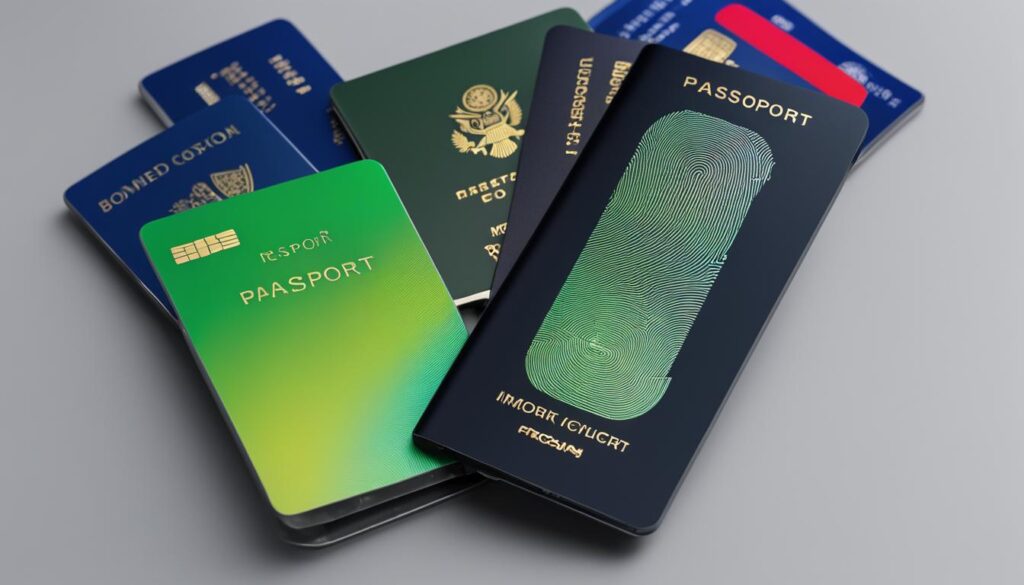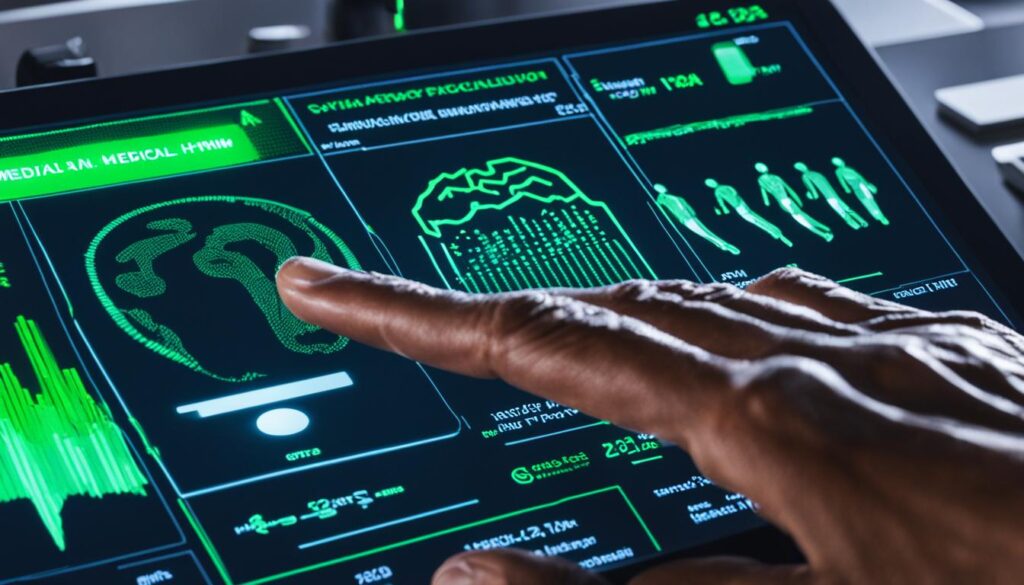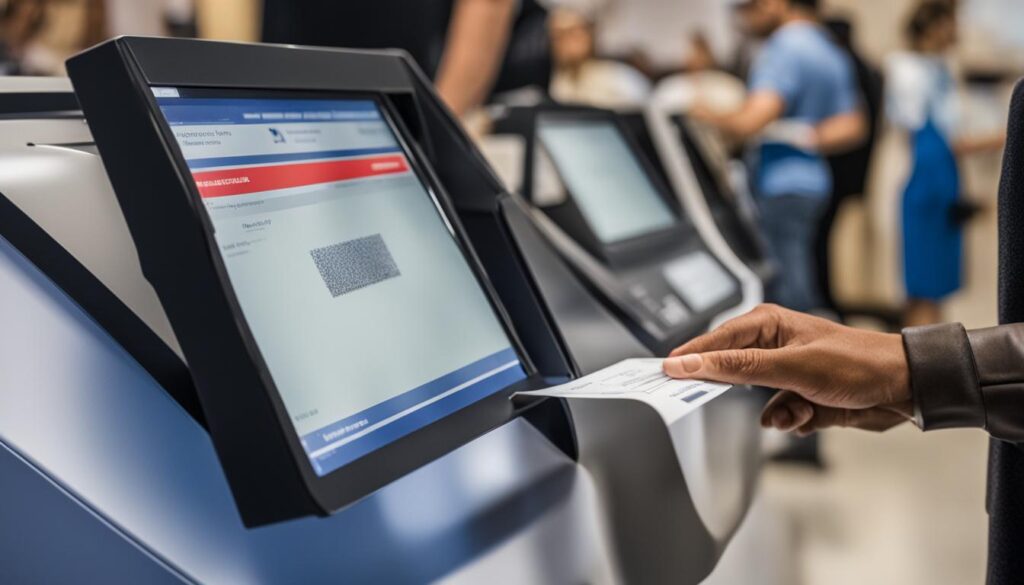Biometric systems have gained increased awareness and acceptance in recent years, with millions of smartphone users utilizing fingerprint or facial recognition to unlock their devices. The integration of information technology (IT) with biometrics plays a crucial role in enhancing security and authentication.
By leveraging IT solutions, biometric systems have been able to advance and provide more secure and convenient methods of identification. From law enforcement to healthcare, IT has revolutionized the way biometrics are utilized.
Contents
- 1 IT Solutions for Law Enforcement and Public Security
- 2 The Role of IT in Military Biometrics
- 3 IT Solutions for Healthcare and Subsidies
- 4 IT in Civil Identity, Population Registration, and Voter Registration
- 5 Conclusion
- 6 FAQ
- 6.1 How does information technology support biometrics?
- 6.2 What are the IT solutions for law enforcement and public security?
- 6.3 What is the role of IT in military biometrics?
- 6.4 How does IT support border control, travel, and migration?
- 6.5 What are the IT applications in healthcare and subsidies?
- 6.6 How is IT used in civil identity, population registration, and voter registration?
- 6.7 What are the benefits of leveraging IT for biometric identification?
- 7 Source Links
Key Takeaways:
- IT plays a crucial role in enhancing the security and authentication of biometric systems.
- Technological advancements in biometrics have been made possible through the integration of IT solutions.
- IT-driven systems such as automated fingerprint identification systems (AFIS) and live face recognition have greatly benefited law enforcement and public security.
- Biometric identification is increasingly used in military operations and border control to ensure the safety and security of nations.
- IT solutions enable efficient and secure healthcare services through biometric authentication and personal data protection.
IT Solutions for Law Enforcement and Public Security
Law enforcement and public security agencies have greatly benefited from the integration of information technology (IT) solutions. These advancements have revolutionized the way biometric data is collected, stored, and analyzed, enhancing security and enabling more efficient processes.
One of the key IT solutions utilized in law enforcement is the Automated Fingerprint Identification System (AFIS). AFIS allows for the storage and retrieval of fingerprint data, enabling forensic analysts to quickly match biometric templates and identify potential suspects. This technology has significantly expedited the investigation process and has proven to be instrumental in solving crimes.
Another essential IT solution in the field of law enforcement biometrics is the Automated Biometric Identification System (ABIS). ABIS goes beyond fingerprints and incorporates other biometric data, such as faces and irises. Law enforcement agencies can store a comprehensive range of biometric information, making it easier to identify individuals and match them to known criminals or persons of interest.
IT-driven technologies like live face recognition have also transformed public security operations. Utilizing sophisticated algorithms and databases, live face recognition systems can identify individuals in real-time, even in crowded environments. This technology plays a vital role in enhancing public safety, as it can quickly detect and alert authorities to potential threats.
“The integration of IT solutions in law enforcement and public security has paved the way for more accurate and efficient identification processes, enabling authorities to protect communities effectively.” – John Davis, Law Enforcement Technology Expert
Benefits of IT Solutions for Law Enforcement and Public Security:
- Enhanced accuracy and speed in matching biometric templates
- Efficient storage, search, and retrieval of biometric data
- Real-time identification in crowded environments
- Increased effectiveness in solving crimes
- Improved public safety and security measures
By embracing IT solutions for law enforcement biometrics, authorities can leverage advanced technologies to streamline operations, identify potential threats, and ensure the safety of communities.
The Role of IT in Military Biometrics
The military utilizes military biometrics for various purposes, although specific details are not readily available due to the classified nature of defense agency operations. The United States military, through the Defense Forensics and Biometrics Agency, has collected biometric data since 2004, including faces, irises, fingerprints, and DNA. The DoD Automated Biometric Information System manages this vast database, which has been instrumental in identifying and apprehending individuals involved in military operations. Biometric identification is increasingly used in identifying non-U.S. citizens on the battlefield.
Biometric technology plays a crucial role in enhancing military operations and ensuring the safety of personnel. By utilizing advanced biometric systems, the military can accurately identify individuals, both friend and foe, improving overall situational awareness and reducing the risk of infiltration or compromise.

Biometric infrastructures and databases are crucial in controlling migration flows and identifying individuals entering and exiting countries. By leveraging biometric authentication, border control authorities can ensure the accuracy and integrity of traveler data, preventing unauthorized entry or exit.
Here is an example of an automated border control system:
Automated Border Control System
Feature Benefits Biometric Authentication Ensures accurate traveler identification Efficient Processing Reduces wait times and congestion at border checkpoints Enhanced Security Prevents unauthorized entry or exit The automated border control system utilizes biometric authentication to verify the traveler’s identity, ensuring accurate identification and reducing the risk of fraudulent documents. This technology-driven solution not only expedites border crossings but also enhances security measures, creating a safer travel environment for all.
IT applications in border control, travel, and migration play a crucial role in ensuring efficient processes and enhanced security measures. The integration of electronic passports, automatic border control systems, and biometric authentication allows for seamless travel experiences while maintaining robust border control protocols.
IT Solutions for Healthcare and Subsidies
Implementing national identity cards supported by information technology offers secure access to governmental services and healthcare in various countries. These cards serve as a means of biometric identification, often utilizing fingerprints, to confirm the identity of individuals seeking healthcare services. The integration of biometric identification systems ensures the confidentiality and protection of personal data, enabling hospitals, pharmacies, and clinics to verify social security rights while maintaining privacy.
By leveraging IT, healthcare insurance programs can streamline the identification and verification process, enhancing efficiency in healthcare delivery. Biometric authentication provides a reliable and accurate method to verify individuals’ identity, minimizing the risk of errors and fraudulent practices.
Personal data protection is a paramount consideration in the implementation of IT solutions for healthcare and subsidies. Robust security measures and encryption protocols safeguard sensitive information, ensuring compliance with privacy regulations and protecting individuals’ personal data.
Benefits of IT Solutions for Healthcare and Subsidies
- Efficient and accurate identification of individuals seeking healthcare services.
- Streamlined verification process for healthcare insurance programs.
- Enhanced privacy and protection of personal data.
- Reduced risk of errors and fraudulent activities.
- Improved efficiency and effectiveness in healthcare delivery.
IT solutions in healthcare and subsidies not only enable easy access to services but also ensure the authenticity and security of individuals’ biometric information.
| Benefits | Description |
|---|---|
| Efficient Identification | IT solutions enable quick and accurate identification of individuals, reducing waiting times in healthcare facilities. |
| Secure Data Storage | Biometric data is stored securely, protecting personal information from unauthorized access. |
| Streamlined Verification | Using biometric identification, healthcare insurance programs can efficiently verify individuals’ eligibility and facilitate access to benefits. |
| Fraud Prevention | Biometric authentication helps mitigate fraudulent activities, ensuring that subsidies and healthcare services are provided to eligible individuals. |
With the integration of IT solutions, healthcare providers can focus on delivering quality care while ensuring a smooth and secure experience for patients accessing healthcare services.

IT in Civil Identity, Population Registration, and Voter Registration
Information technology plays a crucial role in civil identity and population registration systems. One notable example is the Aadhaar project in India, which has provided unique identity numbers to over 1.37 billion Indian residents, ensuring reliable identification and authentication. This biometric identification system utilizes biographic and biometric data, including fingerprints and iris scans, to establish a robust civil identity framework.
Civil Identity and Population Registration
The Aadhaar project has revolutionized civil identity and population registration in India. By capturing and storing biographic and biometric information, such as fingerprints and iris scans, individuals can be reliably identified and authenticated. This ensures secure access to government services, social welfare programs, and financial transactions.
This comprehensive population registration system facilitates efficient service delivery, minimizes identity fraud, and empowers individuals with a unique civil identity that can be used across various sectors. By leveraging IT solutions, civil identity and population registration systems can effectively manage and update vast databases with accurate and up-to-date information.
Moreover, civil identity and population registration systems support national development initiatives by enabling targeted social welfare programs, streamlined governance processes, and enhanced public service delivery.
Voter Registration
Biometric technology has also been instrumental in ensuring fair and transparent voter registration processes. By utilizing unique biometric attributes such as fingerprints or iris scans, voter registration systems can prevent fraudulent voting and uphold the principle of “one person, one vote.”
Biometric voter registration eliminates duplicate registrations, impersonation, and multiple voting by accurately identifying eligible voters. It enhances the integrity of the electoral process, strengthens democratic principles, and fosters trust in the electoral system.
Through the integration of information technology in voter registration systems, governments can efficiently manage voter databases, process voter information, and authenticate the identity of voters. This not only improves the efficiency of elections but also enhances the overall credibility and transparency of the electoral process.
Overall, IT plays a vital role in civil identity, population registration, and voter registration systems, enabling accurate identification, reliable authentication, and improved governance processes.

| Benefits of IT in Civil Identity, Population Registration, and Voter Registration |
|---|
| Efficient service delivery |
| Minimized identity fraud |
| Streamlined governance processes |
| Enhanced public service delivery |
| Fair and transparent voter registration |
| Prevention of fraudulent voting |
| Upholding the principle of “one person, one vote” |
| Improved efficiency of elections |
| Enhanced credibility and transparency of the electoral process |
Conclusion
Information technology (IT) has completely transformed the field of biometrics, providing unparalleled security, authentication, and convenience. The integration of IT solutions across various sectors, including law enforcement, military, border control, healthcare, and civil identity, has revolutionized biometric systems, offering countless benefits and advancements. By leveraging IT, organizations can establish efficient and reliable biometric identification processes, ensuring the integrity and security of individuals’ biometric data.
The advantages of IT in biometrics are extensive, encompassing improved privacy, accuracy, and accessibility. With technology-driven biometric solutions, individuals can enjoy a seamless and secure experience while authorities can effectively tackle security challenges. IT-enabled biometric systems, such as automated fingerprint identification systems (AFIS) and live face recognition, are empowering law enforcement agencies to swiftly identify and apprehend suspects, enhancing public security.
Moreover, the military sector leverages IT for biometric identification, aiding in battlefield operations and the protection of national security. The precise role of IT in military biometrics is not widely disclosed due to the classified nature of defense agency activities. Nevertheless, the Defense Forensics and Biometrics Agency and the DoD Automated Biometric Information System have been instrumental in collecting and managing biometric data for military use.
IT solutions have also greatly impacted border control, travel, and migration management. Biometric passports and electronic gates at airports have significantly expedited border crossings, while biometric authentication ensures secure and seamless travel experiences. Biometric databases and infrastructure play a vital role in managing migration flows and verifying the identity of individuals entering or exiting a country.
In healthcare and civil identity sectors, IT has enabled the implementation of national identity cards, streamlining access to government services and healthcare. Biometric identification, often using fingerprints, guarantees the accuracy of personal data before individuals can access medical services. These systems prioritize data protection and privacy, empowering hospitals and clinics to verify social security rights while maintaining confidentiality.
Overall, the benefits of IT in biometrics are game-changing. Leveraging IT for biometric identification not only enhances security and authentication but also enables organizations to implement reliable and efficient processes. With technology-driven biometric solutions, we can continue to strengthen privacy, accuracy, and accessibility, making IT an indispensable component of modern security systems.
FAQ
How does information technology support biometrics?
Information technology plays a crucial role in biometrics by enhancing security and authentication. IT solutions, such as Automated Fingerprint Identification Systems (AFIS) and Automated Biometric Identification Systems (ABIS), enable the storage, search, and retrieval of biometric information, allowing for quick and accurate identification.
What are the IT solutions for law enforcement and public security?
Law enforcement and public security agencies utilize IT-driven technologies like live face recognition for real-time identification in crowded environments. Automated systems such as AFIS and ABIS help forensic analysts match biometric templates quickly and accurately, aiding in investigations and enhancing public security.
What is the role of IT in military biometrics?
In the military, IT is utilized for biometric data collection, management, and identification. The Defense Forensics and Biometrics Agency collects biometric data, including fingerprints, faces, irises, and DNA. The DoD Automated Biometric Information System manages this data, which has been instrumental in identifying and apprehending individuals involved in military operations.
How does IT support border control, travel, and migration?
IT plays a crucial role in expedited border control and secure travel experiences. Biometric passports and e-gates at airports compare travelers’ faces or fingerprints with data stored in passport microcontrollers, providing efficient and secure authentication. IT infrastructures and databases are also used to control migration flows and identify individuals entering and exiting countries.
What are the IT applications in healthcare and subsidies?
IT supports national identity cards that enable secure access to governmental services and healthcare. Biometric identification, often through fingerprints, is used to confirm individuals’ identities before they can access healthcare services. These systems ensure the protection and confidentiality of personal data, allowing healthcare providers to verify social security rights while maintaining privacy.
How is IT used in civil identity, population registration, and voter registration?
IT solutions are utilized in civil identity and population registration systems to ensure reliable identification and authentication. The Aadhaar project in India, for example, uses biometric data such as fingerprints and iris scans to provide unique identity numbers to residents. Biometric technology is also used in voter registration to prevent fraudulent voting and preserve the principle of “one person, one vote.”
What are the benefits of leveraging IT for biometric identification?
Leveraging IT in biometrics leads to enhanced security, authentication, privacy, accuracy, and accessibility. IT solutions improve the efficiency and reliability of biometric identification processes, ensuring the integrity and security of individuals’ biometric data.




